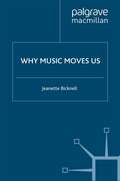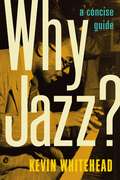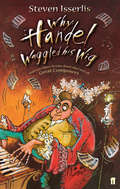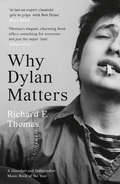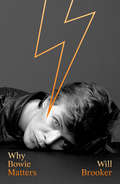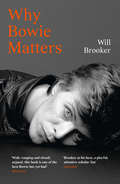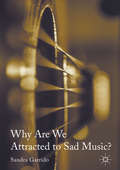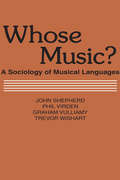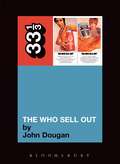- Table View
- List View
Why the Amish Sing: Songs of Solidarity and Identity (Young Center Books in Anabaptist and Pietist Studies)
by D. Rose ElderSinging occurs in nearly every setting of Amish life. It is a sanctioned pleasure that frames all Amish rituals and one that enlivens and sanctifies both routine and special events, from household chores, road trips by buggy, and family prayer to baptisms, youth group gatherings, weddings, and "single girl" sings. But because Amish worship is performed in private homes instead of public churches, few outsiders get the chance to hear Amish people sing. Amish music also remains largely unexplored in the field of ethnomusicology. In Why the Amish Sing, D. Rose Elder introduces readers to the ways that Amish music both reinforces and advances spiritual life, delving deep into the Ausbund, the oldest hymnal in continuous use. This illuminating ethnomusicological study demonstrates how Amish groups in Wayne and Holmes Counties, Ohio�the largest concentration of Amish in the world�sing to praise God and, at the same time, remind themselves of their 450-year history of devotion. Singing instructs Amish children in community ways and unites the group through common participation. As they sing in unison to the weighty words of their ancestors, the Amish confirm their love and support for the community. Their singing delineates their common journey�a journey that demands separation from the world and yielding to God's will.By making school visits, attending worship services and youth sings, and visiting private homes, Elder has been given the rare opportunity to listen to Amish singing in its natural social and familial context. She combines one-on-one interviews with detailed observations of how song provides a window into Amish cultural beliefs, values, and norms.
Why Solange Matters (Music Matters Ser.)
by Stephanie PhillipsThe dramatic story of Solange: a musician and artist whose unconventional journey to international success was far more important than her family name.'Why Solange Matters is a significant and sober treatise on popular music . . . This book is more than necessary.'THURSTON MOOREGrowing up in the shadow of her superstar sister, Beyoncé, and defying an industry that attempted to bend her to its rigid image of a Black woman, Solange Knowles has become a pivotal musician and artist in her own right.In Why Solange Matters, Stephanie Phillips chronicles the creative journey of Solange, a beloved voice of the Black Lives Matter generation. A Black feminist punk musician herself, Phillips addresses not only the unpredictable trajectory of Solange's career but also how she and other Black women see themselves through the musician's repertoire. First, she traces Solange's progress through an inflexible industry, charting the artist's development up to 2016, when the release of her third album, A Seat at the Table, redefined her career. With this record and, then, When I Get Home (2019), Phillips describes how Solange has embraced activism, anger, Black womanhood and intergenerational trauma to inform her remarkable art.Why Solange Matters not only cements the subject in the pantheon of world-changing twenty-first-century musicians, it introduces its writer as an important new voice.
Why Patti Smith Matters
by Caryn RosePatti Smith arrived in New York City at the end of the Age of Aquarius in search of work and purpose. What she found - what she fostered - was a cultural revolution. Through her poetry, her songs, her unapologetic vocal power, and her very presence as a woman fronting a rock band, she kicked open a door that countless others walked through. No other musician has better embodied the "nothing-to-hide" rawness of punk, nor has any other done more to nurture a place in society for misfits of every stripe.Why Patti Smith Matters is the first book about the iconic artist written by a woman. The veteran music journalist Caryn Rose contextualizes Smith's creative work, her influence, and her wide-ranging and still- evolving impact on rock and roll, visual art, and the written word. Rose goes deep into Smith's oeuvre, from her first album, Horses, to acclaimed memoirs operating at a surprising remove from her music. The portrait of a ceaseless inventor, Why Patti Smith Matters rescues punk's poet laureate from "strong woman" clichés. Of course Smith is strong. She is also a nuanced thinker. A maker of beautiful and challenging things. A transformative artist who has not simply entertained but also empowered millions.
Why Music Moves Us
by J. BicknellMusic has extraordinary power to move us, but how and why does it affect us? What is going on, emotionally, physically and cognitively when listeners have strong emotional responses to music? This is a highly readable, original and philosophically important book for anyone who has ever been moved by music.
Why Music Matters
by David HesmondhalghListen to David Hesmondhalgh discuss the arguments at the core of 'Why Music Matters' with Laurie Taylor on BBC Radio 4's Thinking Allowed here. In what ways might music enrich the lives of people and of societies? What prevents it from doing so? Why Music Matters explores the role of music in our lives, and investigates the social and political significance of music in modern societies. First book of its kind to explore music through a variety of theories and approaches and unite these theories using one authoritative voice Combines a broad yet theoretically sophisticated approach to music and society with real clarity and accessibility A historically and sociologically informed understanding of music in relation to questions of social power and inequality By drawing on both popular and academic talk about a range of musical forms and practices, readers will engage with a wide musical terrain and a wealth of case studies
Why Music Matters
by David HesmondhalghListen to David Hesmondhalgh discuss the arguments at the core of 'Why Music Matters' with Laurie Taylor on BBC Radio 4's Thinking Allowed here. In what ways might music enrich the lives of people and of societies? What prevents it from doing so? Why Music Matters explores the role of music in our lives, and investigates the social and political significance of music in modern societies. First book of its kind to explore music through a variety of theories and approaches and unite these theories using one authoritative voice Combines a broad yet theoretically sophisticated approach to music and society with real clarity and accessibility A historically and sociologically informed understanding of music in relation to questions of social power and inequality By drawing on both popular and academic talk about a range of musical forms and practices, readers will engage with a wide musical terrain and a wealth of case studies
Why Marianne Faithfull Matters
by Tanya PearsonA remarkable feminist history and biography that features fragments from the five-decade career of an iconic artist.'Through this deeply personal take, the real significance of Faithfull as an irrepressible female icon shines through.'SHINDIG'Excellent . . . Pearson deserves the widest possible audience.'POPMATTERS'With vulnerability and a smart sense of humor, Tanya Pearson exposes the profoundly misogynistic music industry that abused Marianne Faithfull . . . heroic and hiliarious.'JD SAMSON, of LeTigre and MEN'Witty, passioante, and provactive. Finally, a feminist appreciation for Marianne Faithfull.'VIVIEN GOLDMAN, author of Revenge of the She-Punks: A Feminist Music History from Poly Styrene to Pussy RiotFirst as a doe-eyed ingénue with 'As Tears Go By', then as a gravel-voiced phoenix rising from the ashes of the 1960s with a landmark punk album, Broken English, and finally as a genre-less icon, Marianne Faithfull carved her name into the history of rock 'n' roll to chart a career spanning five decades and multiple detours.Why, then, was Faithfull absent from the male-dominated history of the British Invasion?Putting memoir on equal footing with biographical accounts, historian Tanya Pearson writes about Faithfull as an avid fan, recovered addict and queer musician at a crossroads. Whether exploring Faithfull's rise to celebrity, her drug addiction and fall from grace as a spurned 'muse' or her reinvention as a sober, soulful chanteuse subverting all expectations for an ageing woman in music, Pearson reaffirms the deep connection between creator and listener in this remarkable feminist history of the iconic artist
Why Mahler?: How One Man and Ten Symphonies Changed the World
by Norman LebrechtA century after his death, Gustav Mahler is the most important composer of modern times. Displacing Beethoven as a box-office draw, his music offers more than the usual listening satisfactions. Many believe it has the power to heal emotional wounds and ease the pain of death. Others struggle with the intellectual fascination of its contradictory meanings. Long, loud and seldom easy, his symphonies are used to accompany acts of mourning and Hollywood melodramas. Sometimes dismissed as death-obsessed, Mahler is more alive in the 21st century than ever before. Why Mahler? Why does a Jewish musician from a land without a name capture the yearnings and anxieties of post-industrial society? Is it the music, it is the man, or is it the affinity we feel with his productive peak - a decade when Freud, Einstein, Picasso, Joyce and Mahler reconfigured the ways we understand life on earth? In this highly original account of Mahler's life and work, Norman Lebrecht - renowned writer, critic and cultural commentator - explores the Mahler Effect, a phenomenon that reaches deep into unsuspecting lives, altering the self-perceptions of world leaders, finance chiefs and working musicians. Why Mahler? is a multi-layered exploration of the role that music plays as a soundtrack to our lives.
Why Karen Carpenter Matters (Music Matters)
by Karen TongsonA PITCHFORK MUSIC BOOK OF THE YEARA radical, literary and intimate insight into one of the twentieth century's most vital vocalists. 'Tongson serves up a number of astute observations about fantasy, projection, longing, normalcy, and aberrance.' MAGGIE NELSON'Deftly weaves memoir, history, and cultural criticism to highlight the dynamic relationship between artists and listeners.'PITCHFORKIn the '60s and '70s, America's music scene was marked by raucous excess, reflected in the tragic overdoses of young superstars such as Jimi Hendrix and Janis Joplin. At the same time, the uplifting harmonies and sunny lyrics that propelled Karen Carpenter and her brother, Richard, to international fame belied a different sort of tragedy - the underconsumption that led to Karen's death at age thirty-two from the effects of an eating disorder.In Why Karen Carpenter Matters, Karen Tongson (whose parents named her after the pop icon) interweaves the story of the singer's rise to fame in the 1960s and '70s with her own trans-Pacific journey between the Philippines - where imitations of American pop styles flourished - and Karen Carpenter's home ground of Southern California. Tongson reveals why the Carpenters' chart-topping, seemingly white-washed musical fantasies of 'normal love' have profound significance for her - as well as for other people of colour, LGBT+ communities, and anyone outside the mainstream culture usually associated with Karen Carpenter's legacy.This hybrid of memoir and biography excavates the destructive perfectionism at the root of the Carpenters' sound, while finding the beauty in the singer's all-too-brief life.'Engrossing . . . a triumphant delight.' 4COLUMNS'Heartfelt . . . excellent . . . breathtaking.' EXCLAIM!'Will resonate with readers who have never even heard of Carpenter.' LITERARY HUBMUSIC MATTERS: SHORT BOOKS ABOUT THE ARTISTS WE LOVE- Why Solange Matters by Stephanie Phillips- Why Marianne Faithfull Matters by Tanya Pearson- Why Karen Carpenter Matters by Karen Tongson
Why Jazz?: A Concise Guide
by Kevin WhiteheadWhat was the first jazz record? Are jazz solos really improvised? How did jazz lay the groundwork for rock and country music? In Why Jazz?, author and NPR jazz critic Kevin Whitehead provides lively, insightful answers to these and many other fascinating questions, offering an entertaining guide for both novice listeners and long-time fans. Organized chronologically in a convenient question and answer format, this terrific resource makes jazz accessible to a broad audience, and especially to readers who've found the music bewildering or best left to the experts. Yet Why Jazz? is much more than an informative Q&A; it concisely traces the century-old history of this American and global art form, from its beginnings in New Orleans up through the current postmodern period. Whitehead provides brief profiles of the archetypal figures of jazz--from Louis Armstrong and Duke Ellington to Wynton Marsalis and John Zorn--and illuminates their contributions as musicians, performers, and composers. Also highlighted are the building blocks of the jazz sound--call and response, rhythmic contrasts, personalized performance techniques and improvisation--and discussion of how visionary musicians have reinterpreted these elements to continually redefine jazz, ushering in the swing era, bebop, cool jazz, hard bop, and the avant-garde. Along the way, Why Jazz? provides helpful plain-English descriptions of musical terminology and techniques, from "blue notes" to "conducted improvising." And unlike other histories which haphazardly cover the stylistic branches of jazz that emerged after the 1960s, Why Jazz? groups latter-day musical trends by decade, the better to place them in historical context. Whether read in self-contained sections or as a continuous narrative, this compact reference presents a trove of essential information that belongs on the shelf of anyone who's ever been interested in jazz.
Why Jazz?: A Concise Guide
by Kevin WhiteheadWhat was the first jazz record? Are jazz solos really improvised? How did jazz lay the groundwork for rock and country music? In Why Jazz?, author and NPR jazz critic Kevin Whitehead provides lively, insightful answers to these and many other fascinating questions, offering an entertaining guide for both novice listeners and long-time fans. Organized chronologically in a convenient question and answer format, this terrific resource makes jazz accessible to a broad audience, and especially to readers who've found the music bewildering or best left to the experts. Yet Why Jazz? is much more than an informative Q&A; it concisely traces the century-old history of this American and global art form, from its beginnings in New Orleans up through the current postmodern period. Whitehead provides brief profiles of the archetypal figures of jazz--from Louis Armstrong and Duke Ellington to Wynton Marsalis and John Zorn--and illuminates their contributions as musicians, performers, and composers. Also highlighted are the building blocks of the jazz sound--call and response, rhythmic contrasts, personalized performance techniques and improvisation--and discussion of how visionary musicians have reinterpreted these elements to continually redefine jazz, ushering in the swing era, bebop, cool jazz, hard bop, and the avant-garde. Along the way, Why Jazz? provides helpful plain-English descriptions of musical terminology and techniques, from "blue notes" to "conducted improvising." And unlike other histories which haphazardly cover the stylistic branches of jazz that emerged after the 1960s, Why Jazz? groups latter-day musical trends by decade, the better to place them in historical context. Whether read in self-contained sections or as a continuous narrative, this compact reference presents a trove of essential information that belongs on the shelf of anyone who's ever been interested in jazz.
Why Handel Waggled His Wig: And Lots More Stories About The Lives Of Great Composers
by Steven IsserlisThe eagerly awaited follow-up to the best-selling Why Beethoven Threw the Stew.What did Haydn's wife use for curling-paper for her hair?What did Schubert do with his old spectacles case?Why was Dvorák given a butcher's apron when he was a little boy?Why did Tchaikovsky spit on a map of Europe?Why did Fauré find a plate of spinach on his face?And why did Handel waggle his wig?In Why Beethoven Threw the Stew, renowned cellist Steven Isserlis set out to pass on to children a wonderful gift given to him by his own cello teacher - the chance to people his own world with the great composers by getting to know them as friends. In his new book he draws us irresistibly into the world of six more favourite composers, bringing them alive in a manner that cannot fail to catch the imagination of children encountering classical music for the first time. Once again the text is packed with facts, dates and anecdotes, interspersed with lively black-and-white line illustrations, making this an attractive and accessible read for children to enjoy on their own or share with an adult.'If Why Beethoven Threw the Stew does not turn your child into a music lover, the chances are nothing will.' Daily Mail
Why Dylan Matters
by Richard F. ThomasA GUARDIAN AND INDEPENDENT BEST MUSIC BOOK OF 2017. ‘At last an expert classicist gets to grips with Bob Dylan’ Mary Beard ‘Thomas’s elegant, charming book offers something for everyone – not just the super-fans’ Independent
Why Bowie Matters
by Will BrookerA unique, moving and dazzlingly researched exploration of the places, people, musicians, writers and filmmakers that inspired David Jones to become David Bowie, what we can learn from his life’s work and journey, and why he will always matter.
Why Bowie Matters
by Will BrookerA unique, moving and dazzlingly researched exploration of the places, people, musicians, writers and filmmakers that inspired David Jones to become David Bowie, what we can learn from his life’s work and journey, and why he will always matter.
Why Beethoven Threw the Stew: And Lots More Stories About the Lives of Great Composers
by Steven IsserlisIn Why Beethoven Threw the Stew, renowned cellist Steven Isserlis sets out to pass on to children a wonderful gift given to him by his own cello teacher - the chance to people his own world with the great composers by getting to know them as friends. Witty and informative at the same time, Isserlis introduces us to six of his favourite composers: the sublime genius Bach, the quicksilver Mozart, Beethoven with his gruff humour, the shy Schumann, the prickly Brahms and that extraordinary split personality, Stravinsky. Isserlis brings the composers alive in an irresistible manner that can't fail to catch the attention of any child whose ear has been caught by any of the music described, or anyone entering the world of classical music for the first time. The lively black and white line illustrations provide a perfect accompaniment to the text, and make this book attractive and accessible for children to enjoy on their own or share with an adult.
Why Are We Attracted to Sad Music?
by Sandra GarridoIn this book, perspectives in psychology, aesthetics, history and philosophy are drawn upon to survey the value given to sad music by human societies throughout history and today. Why do we love listening to music that makes us cry? This mystery has puzzled philosophers for centuries and tends to defy traditional models of emotions. Sandra Garrido presents empirical research that illuminates the psychological and contextual variables that influence our experience of sad music, its impact on our mood and mental health, and its usefulness in coping with heartbreak and grief. By means of real-life examples, this book uses applied music psychology to demonstrate the implications of recent research for the use of music in health-care and for wellbeing in everyday life.
Why Are We Attracted to Sad Music?
by Sandra GarridoIn this book, perspectives in psychology, aesthetics, history and philosophy are drawn upon to survey the value given to sad music by human societies throughout history and today. Why do we love listening to music that makes us cry? This mystery has puzzled philosophers for centuries and tends to defy traditional models of emotions. Sandra Garrido presents empirical research that illuminates the psychological and contextual variables that influence our experience of sad music, its impact on our mood and mental health, and its usefulness in coping with heartbreak and grief. By means of real-life examples, this book uses applied music psychology to demonstrate the implications of recent research for the use of music in health-care and for wellbeing in everyday life.
Whose Music?: Sociology of Musical Languages
by John ShepherdWhose Music? combines historical, musicological, and sociological materials and styles of analysis in ways that connect to the field of sociology. The analyses of social class systems presented here speak in translatable ways to analyses of musical forms. Not only that, both are connected to an understanding of the organizations through which works are distributed to their audiences. Perhaps most importantly for the contemporary reader, this book depicts the part of the process by which dominant class groups justify their domination--cultural and otherwise.
Whose Music?: Sociology of Musical Languages
by John ShepherdWhose Music? combines historical, musicological, and sociological materials and styles of analysis in ways that connect to the field of sociology. The analyses of social class systems presented here speak in translatable ways to analyses of musical forms. Not only that, both are connected to an understanding of the organizations through which works are distributed to their audiences. Perhaps most importantly for the contemporary reader, this book depicts the part of the process by which dominant class groups justify their domination--cultural and otherwise.
Whose Master's Voice?: The Development of Popular Music in Thirteen Cultures (Contributions to the Study of Music and Dance)
by Fouli T. PapageorgiouWhat are the interactions between transnational communication and national cultures? This work attempts to answer this critical question in the study of culture and communication. It takes as its vehicle of study the music industry and music making in 13 different cultures, presenting an insider's view of a global cultural experience. Of interest to musicologists and sociologists alike, plus anyone fascinated by distant cultures and how they are affected by external as well as internal communication systems.The chapters are a collection of research findings produced for the International Communications and Youth Cultures Consortium (ICYC), an informal group of international scholars in many disciplines who are committed to understanding the economic and social factors that influence cultures and youth. Their point of view in this work is their individual country and the tensions that arise from the development of international communication systems. Each view is from inside the country; external influences are not subjects of study in themselves but are viewed as part of a complex scene along with other variables operating in various national situations.
Whose Blues?: Facing Up to Race and the Future of the Music
by Adam GussowMamie Smith's pathbreaking 1920 recording of "Crazy Blues" set the pop music world on fire, inaugurating a new African American market for "race records." Not long after, such records also brought black blues performance to an expanding international audience. A century later, the mainstream blues world has transformed into a multicultural and transnational melting pot, taking the music far beyond the black southern world of its origins. But not everybody is happy about that. If there's "No black. No white. Just the blues," as one familiar meme suggests, why do some blues people hear such pronouncements as an aggressive attempt at cultural appropriation and an erasure of traumatic histories that lie deep in the heart of the music? Then again, if "blues is black music," as some performers and critics insist, what should we make of the vibrant global blues scene, with its all-comers mix of nationalities and ethnicities? In Whose Blues?, award-winning blues scholar and performer Adam Gussow confronts these challenging questions head-on. Using blues literature and history as a cultural anchor, Gussow defines, interprets, and makes sense of the blues for the new millennium. Drawing on the blues tradition's major writers including W. C. Handy, Langston Hughes, Zora Neale Hurston, and Amiri Baraka, and grounded in his first-person knowledge of the blues performance scene, Gussow's thought-provoking book kickstarts a long overdue conversation.
Who’s Who and What’s What in Wagner
by Jonathan LewseyWho‘s Who and What‘s What in Wagner aims to fill a notable gap in the extensive literature surrounding the works of Richard Wagner. It is a comprehensive reference work in which all the many complexities of character, plot and language in Wagner‘s operas, from Die Feen to Parsifal, are elucidated. For ease of reference the book is arranged alphabetically in the style of an encyclopaedia. Herein will be found succinct synopses of all the operas; in-depth biographies of all the characters; a lexicon of difficult words and phrases; plus an appendix comprising a select bibliography and discography. Whether the reader be a casual opera lover, or specialist involved in the production or performance of Wagner‘s works, this book will prove to be an invaluable companion. Contents include: Alphabetical Listing including: 86 in-depth character studies; Synopsis for each of the 13 operas; Over 1,000 further entries about names, places and artifacts that feature in Wagner‘s works; Index.
Who’s Who and What’s What in Wagner
by Jonathan LewseyWho‘s Who and What‘s What in Wagner aims to fill a notable gap in the extensive literature surrounding the works of Richard Wagner. It is a comprehensive reference work in which all the many complexities of character, plot and language in Wagner‘s operas, from Die Feen to Parsifal, are elucidated. For ease of reference the book is arranged alphabetically in the style of an encyclopaedia. Herein will be found succinct synopses of all the operas; in-depth biographies of all the characters; a lexicon of difficult words and phrases; plus an appendix comprising a select bibliography and discography. Whether the reader be a casual opera lover, or specialist involved in the production or performance of Wagner‘s works, this book will prove to be an invaluable companion. Contents include: Alphabetical Listing including: 86 in-depth character studies; Synopsis for each of the 13 operas; Over 1,000 further entries about names, places and artifacts that feature in Wagner‘s works; Index.
The Who's The Who Sell Out (33 1/3)
by John DouganReleased in the U.S. in January 1968, The Who Sell Out was, according to critic Dave Marsh, a complete backfire--the album sold well, but not spectacularly [and was] ultimately a nostalgic in-joke: Who but a pop intellectual could appreciate such a thing? Further rarifying its in-joke status was its unapologetic Englishness; 13 tracks stitched together in a mock pirate radio broadcast, without a DJ, with cool, anglocentric commercials to boot. In the 36 years since its release, Sell Out, though still not the best selling release in The Who's catalog, has been embraced by a growing number of fans who regard it as the band's best work, one of the few recordings of the late 1960s that best represents the ambitious aesthetic possibilities of the concept album without becoming mired in a bog of smug, self-aggrandizing, high art aspirations. Sell Out, powerfully and ecstatically, articulates the nexus of pop music and pop culture.As much as it is an expression of the band's expanding sonic palette, Sell Out also functions as a critique of the rock and roll lifestyle. Not the clichéd mantra of sex, drugs, and rock and roll but in the ways that commercial advertising fabricates a youth-oriented cultural reality by hawking pimple cream, deodorant, food, musical equipment, etc., and linking it with rock and roll. In this sense Sell Out is a reflective work, one that struggles with rock and roll as a cultural expression that aspires to aesthetic permanence while marketed as ephemera. From this conflict emerges a pop art masterpiece.



